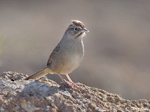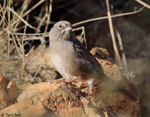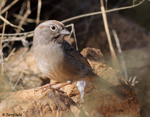| Length: 6 inches | Wingspan: 7.75 inches | Seasonality: Non-resident in South Dakota |
| ID Keys: Rufous crown, white malar stripe with dark stripe below it, white eye-ring, gray below, rufous streaks on upper back | ||
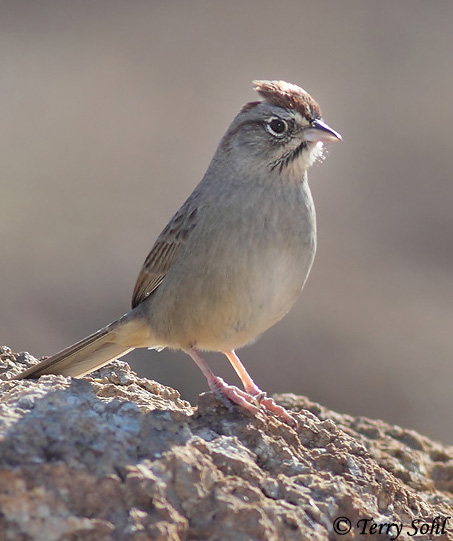 The
Rufous-crowned Sparrow is a bird of rocky, brushy areas of the southwestern
U.S., southern Great Plains, and Mexico. In range, they are sometimes
referred to as "Rock Sparrows" by the local populus, given their preference
for rocky habitats. There they are usually sighted as foraging pairs,
moving deliberately along the ground in search of insects and seeds.
There are many recognized sub-species of Rufous-crowned Sparrows, each with
minor differences in plumage and/or song.
The
Rufous-crowned Sparrow is a bird of rocky, brushy areas of the southwestern
U.S., southern Great Plains, and Mexico. In range, they are sometimes
referred to as "Rock Sparrows" by the local populus, given their preference
for rocky habitats. There they are usually sighted as foraging pairs,
moving deliberately along the ground in search of insects and seeds.
There are many recognized sub-species of Rufous-crowned Sparrows, each with
minor differences in plumage and/or song.
Habitat: Found in rocky, brushy areas, such as arid rocky scrub of the desert Southwest, or shrubby areas on rocky outcrops in the southern Great Plains.
Diet: Feeds on insects and seeds, with insects and spiders making up most of the summer diet, and seeds making up a larger part of the diet in winter.
Behavior: Forages by walking along the ground, moving deliberately in search of food. Will also sometimes forages low in the foliage of shrubs or weeds. They are usually found foraging in pairs.
Nesting: The nest of a Rufous-crowned Sparrow is a cup of grasses, weeds, and twigs, built on the ground in a protected area such as the base of a shrub or small tree. The female lays 3 or 4 eggs, with the female incubating them. Upon hatching, both parents help to feed the young, who leave the nest after about 10 days.
Song: The song of a Rufous-crowned Sparrow is a rough chattering that descends in pitch. Also has a nasal "deer deer deer" call.
Migration: Considered a permanent resident throughout its range, although some birds at the northern end of their range may move short distances southward for the winter.
Interactive eBird Map: Click here to access an interactive eBird map of Rufous-crowned Sparrow sightings
Similar Species: In range, most likely to be confused with Cassin's Sparrow, Rufous-winged Sparrow, or Botteri's Sparrow.
Feeders: Will occasionally attend feeders for various seeds.
Conservation Status: The Rufous-crowned Sparrow does appear to be declining in population in some areas, likely due to habitat loss. However, they are still widespread and are relatively common in some parts of their range. The IUCN lists the Rufous-crowned Sparrow as a species of "Least Concern".
Further Information: 1) California Partners in Flight - Rufous-crowned Sparrow
2) Audubon Guide - Rufous-crowned Sparrow
3) WhatBird - Rufous-crowned Sparrow
Photo Information: Photo taken on December 10th, 2010 - Outskirts of Tucson, Arizona - Terry Sohl
| Click below for a higher-resolution map |
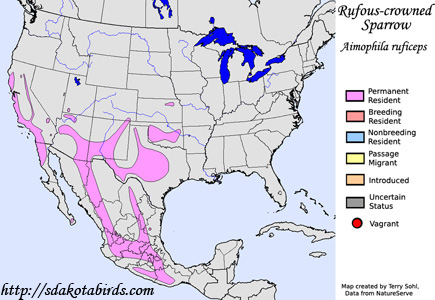 |
| South Dakota Status: Non-resident in South Dakota |
Additional Rufous-crowned Sparrow Photos
Click for a higher-resolution version of these photos
